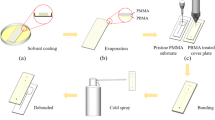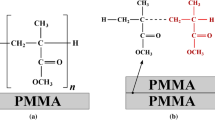Abstract
The bond strength dependence on bonding temperature and bonding pressure in traditional thermal bonding and surface modification bonding of PMMA is investigated. The results show that the bond strength of the latter bonding method is larger than the former. The effects of post-annealing and aging on bond strength are also demonstrated. Then the bonding parameters of temperature and pressure are optimized, and typical bond strength of 1 MPa is obtained at bonding temperature of 95°C, bonding pressure at 2 MPa, bonding time for 3 min and 50°C post-annealing for 2 h. The successful bonded microfluidic device was obtained through this optimized thermal bonding method.
Similar content being viewed by others
Explore related subjects
Discover the latest articles, news and stories from top researchers in related subjects.Avoid common mistakes on your manuscript.
1 Introduction
Microfluidic or lab-on-chip devices have attracted increasing interest over the last decade (Becker and Locascio 2002). Glass was initially the material of these devices, but polymers (Zhao et al. 2003) such as polymethyl methacrylate (PMMA) have a great potential to be used for these devices because of its low cost, easily fabrication, and chemical properties (Becker and Locascio 2002). A key step in the fabrication of these microfluidic devices is the enclosing of microchannel by cover plate. This layer-to-layer bonding is a very important procedure and challenging issue in the design and fabrication of polymer-based microfluidic devices. Several methods for the bonding of PMMA substrates have been demonstrated, including thermal bonding in convection oven or in hot embossing machine (Kelly and Woolley 2003; Fiorini et al. (2003), gluing (such as SU-8 resist, PDMS films, etc.) (Han et al. 2003), laser lamination (Roberts et al. 1997), and surface modification (associated with other bonding methods) (Lee et al. 2003; Zhu et al. 2004). Among these methods, thermal bonding is currently the mostly used method. For the thermal bonding method, the bonding parameters’ affect on the bond strength and the breakage of microstructures need to be evaluated and optimized for the bonding process. In this article, two methods of PMMA wafer boding, namely the traditional thermal bonding and surface modification bonding were performed. Bonding temperature, surface modification and pressure’s effect on bond strength was investigated and optimized, post-annealing and aging’s effect on bond strength is also presented.
2 Experiments
2.1 Microchannel fabrication
The microchannel structure (see Fig. 1a) were fabricated in hot embossing system HEX 02 (JENO0PTIK Mikrotechnik GmbH, Germany) by Ni mould (see Fig. 1b) which is fabricated through UV-LIGA technique.
2.2 Traditional thermal bonding
The blank PMMA substrate and patterned microchannel PMMA were put together and heated to the bonding temperature before the bonding pressure was applied in hot embossing system HEX 02. After bonding pressure was applied, the bonding temperature was kept constant for minutes before cooling down. When the substrate was cooled down to 75°C, the bonding pressure was unloaded, then the bonded sample was cooled down to room temperature slowly. In this experiment, the bonding pressure ranged from 0.5 to 2.5 MPa, bonding temperature ranged from 88 to 100°C. The bonded PMMA samples were post-annealed at 50°C in oven for 2 h.
2.3 Surface modification bonding
The surface of PMMA is modified with its monomer (MMA) before bonding which developed by Zhu et al. (2004) as in the article. After surface modification, the PMMA substrates were clamped and to be thermal bonded in the hot embossing system.
2.4 Bond strength measuring
The bond strength dependence on bonding pressure and temperature was measured by tensile testing in MTS 809 system (MTS Systems Co., USA). The tensile load was increased with the ratio of 30 N/s. The maximum force was divided by the bonded area to calculate the bond strength before failure.
3 Results and discussions
3.1 Bonding temperature’s effect on bond strength
Figure 2 shows the bonding temperature’s effect on bond strength of both bonding methods. In this figure, it can be seen that the bond strength of surface modification is high and steady for bonding temperature from 91 to 97°C.
Higher temperature will damage the patterns although it can heighten the bond strength. For example, the microchannel collapsed at the bonding temperature of 100°C (see Fig. 3a). At bonding temperature of 97°C, sidewalls of the microchannels draped (see Fig. 3b). At lower bonding temperature, the microchannels (Seen as Fig. 3c–d) retain the same as the embossed microchannel. In order to obtain considerable bond strength and high quality of bonded microchannel, temperature of 91–95°C was chosen as the bonding temperature for the surface modification bonding.
3.2 Bonding pressure’s effect on bond strength
In this case, 95°C was selected as the bonding temperature. Figure 4 shows the bonding pressure’s effect on bond strength of the two bonding methods. The bonding pressure’s effect on bonding quality is also demonstrated in Fig. 5. The sidewalls of microchannels draped at bonding pressure of 3.0 MPa (see Fig. 5a), while others remained well when bonding pressure was below 3.0 MPa (see Fig. 5b–d). In order to obtain high quality bonded microchannel and considerable bond strength, bonding pressure should not be higher than 2.5 MPa.
3.3 Post-annealing and aging’s effect on bond strength
The experiments show that post-annealing (50°C for 2 h) heighten the bond strength considerably for the two bonding methods (see Fig. 6a). Inner stress of the bonding interface may reduce during the post-annealing process which can heighten the bond strength. The bond strength was measured to investigate the aging’s effect (see Fig. 6b). It can be seen that the bond strength of surface modification is steady for aging, while the bond strength of traditional thermal bonding was affected by post-annealing and aging more easily. The results indicate that the bond strength of surface modification is steadier than traditional thermal bonding.
The parameters of surface modification bonding are optimized as the following: bonding temperature at 95°C, bonding pressure at 2 MPa, bonding time for 3 min, post-annealing as 50°C for 2 h. Cross-section SEM of successfully bonded microchannel is shown in Fig. 7. The seal of bonded channel is tested through filling with fuchsine–NaOH solution, and no leakage can be seen.
Compared to the traditional thermal bonding, surface modification bonding method can get successful bonding at lower bonding temperature and pressure, because that surface modified with MMA decreases surface Tg (glass transition temperature) of PMMA and the adhesion work, which will protect the micropatterns during bonding.
4 Conclusion
The bonding strength increases with the bonding temperature and pressure. Bond strength of surface modification bonding of PMMA is higher than that of traditional thermal bonding of PMMA for the same experiment condition. Surface modification bonding method can get successful bonding at lower bonding temperature and pressure which can protect the microstructures during the bonding process.
References
Han A, Wang O, Graff M et al (2003) Multi-layer plastic/glass microfluidic systems containing electrical and mechanical functionality. Lab Chip 3:150–157
Zhao DS, Roy B, McCormick MT et al (2003) Rapid fabrication of a poly (dimethylsiloxane) microfluidic capillary gel electrophoresis system utilizing high precision machining. Lab Chip 3:93–99
Fiorini GS, Jeffries GDM, Lim DSW et al (2003) Fabrication of thermoset polyester microfluidic devices and embossing masters using rapid prototyped poly dimethylsiloxane molds. Lab Chip 3:158–163
Becker H, Locascio LE (2002) Review: polymer microfluidic devices. Talanta 56:267–287
Lee HS, Kim DS, Kwon TH (2003) A novel low temperature bonding technique for plastic substrates using X-ray irradiation. In: Digest. tech. papers transducers ’03 conference, Boston, 8–12 June 2003, pp 1331–1334
Roberts MA, Rossier JS, Bercier P et al (1997) UV laser machined polymer substrates for the development of microdiagnostic systems. Anal Chem 69:1973–1978
Kelly RT, Woolley AT (2003) Thermal bonding of polymeric capillary electrophoresis microdevices in water. Anal Chem 75:1941–1945
Zhu X, Liu G, Tian Y (2004) A new method of layer-to-layer bonding of PMMA. In: The 4th international workshop on microfactories (IWMF), Shanghai, 15–17 October 2004
Author information
Authors and Affiliations
Corresponding author
Rights and permissions
About this article
Cite this article
Zhu, X., Liu, G., Guo, Y. et al. Study of PMMA thermal bonding. Microsyst Technol 13, 403–407 (2007). https://doi.org/10.1007/s00542-006-0224-x
Received:
Accepted:
Published:
Issue Date:
DOI: https://doi.org/10.1007/s00542-006-0224-x











